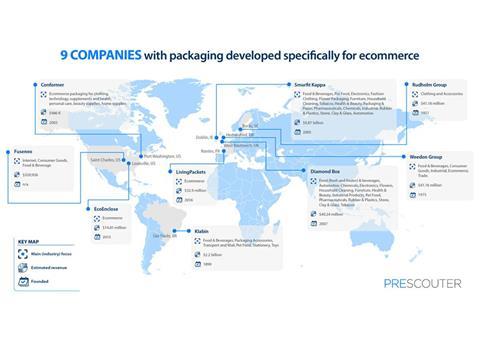
A recent report by research intelligence firm PreScouter highlights innovative packaging solutions developed specifically for e-commerce. Here, Beatriz Gonçalves, materials engineer and coauthor of the Intelligence Brief, discusses the importance of packaging innovations that can enhance supply chain issues, branding, and sustainability goals.
The online sales industry skyrocketed in 2020, reflecting the increase in demand due to the coronavirus pandemic. The greater need to buy online due to restriction measures and social distancing contributed to the change in society’s consumption habits, and it is expected that part of this shift to online sales will continue due to convenience, especially with the greater number of companies that have decided to engage in e-commerce.
The packaging used to transport goods from distribution centers to homes is often the same used in retail today: the same primary packaging is accommodated in boxes and then shipped. However, we have observed a trend toward the development of packaging specifically for e-commerce, which does not necessarily have the same functions as traditional retail packaging.
Traditional retail packaging is closely related to aesthetics. In the case of e-commerce, the main functionality of the packaging is to guarantee the protection of the product, that the goods reach the consumer intact. Packaging will often face an unpredictable postal system, and the consequences of a damaged product can even impact brand reputation.
A look at the e-commerce packaging market
More packaging developments aimed specifically at e-commerce applications are expected as the market expands further. In 2020, the size of the e-commerce packaging market was valued at US$49.2 billion, and the expected growth over the period 2020-2025 is estimated at around 15%, reaching $98.2 billion.
With the pandemic, the packaging industry needed to improve its performance in several ways, balancing sustainability goals with the need for cost-effective operations as well as cleaning and hygiene requirements, which have become priorities. Some of the main challenges brands are facing include optimizing retail packages for home delivery, reducing costs, and avoiding unnecessary packaging.
Latest innovations in packaging developed for e-commerce
Nine companies that provide packaging developed specifically for e-commerce were analyzed in the PreScouter Intelligence Brief. Durability, sustainability, and ease of use were among the challenges most considered by companies during the development of these products.

E-commerce packaging with durability in mind
Durability in e-commerce packaging is mainly related to maintaining the integrity of the product during the journey and how the packages are processed and delivered without damage to their destinations. Details such as improved stability for stacking on pallets, adaptation to conveyor belts, and presentation of the package at the destination are also important. If we consider product returns, durability is an even more important factor, as many times the same package will have to face the entire journey in the opposite direction.
This is one of the main aspects that Amazon has taken into account in its certification program. With the help of machine learning algorithms, products that have the highest customer-reported damage rates were identified to undergo laboratory journey simulation.
Despite mentioning many innovative features, durability is the attribute that draws the most attention in The Box, developed by LivingPackets. The material used in this packaging, expanded polypropylene, is one of the most unique PreScouter has found on the market. It makes the packaging much more durable compared to regular cardboard boxes and allows the same box to be used for up to 1000 trips before it needs reconditioning.
Another way to develop packages with durability in mind is to create packages that are custom made for what is being shipped, so it doesn’t have a large empty space inside the package. Shipping a small item in a large package is one of the easiest ways to damage packages, according to Bob Makofsky, Co-Founder and General Manager of packaging maker Conformer Products, Inc. in an exclusive interview with PreScouter. The use of less material, in addition to being related to the durability and manufacturing costs of packaging and shipping, is also related to sustainability, another e-commerce packaging trend.
E-commerce packaging with sustainability in mind
Sustainability is currently one of the biggest topics discussed when it comes to packaging in general. Within this theme, developments are mainly focused on plastic-free packaging and the shift to packaging made from paper and corrugated cardboard.
Aspects related to sustainability range from recycled or renewable raw materials and the possibility of subsequent recycling to transport methods with low fuel consumption to reduce the environmental impact of deliveries. Some companies even mention a trend called eco-commerce, which focuses on minimal and reusable packaging, refills, and the reverse logistics involved.
EcoEnclose, profiled in the Intelligence Brief, is a company specifically focused on sustainability and eco-friendly packaging, providing products with recycled content that are biodegradable and encouraging reuse whenever possible.
E-commerce packaging with ease of use in mind
Another major trend concerns ease of use. This set of features benefits both companies, who can package their products faster using mechanisms such as easy-to-assemble and self-sealing strips, and end consumers, who seek easier-to-open packages such as those with easy-open mechanisms.
For example, of the companies highlighted in the PreScouter Intelligence Brief, Conformer claims that their mailer can be packed, sealed, and ready to be shipped in 23 seconds, less than one-third of the time it takes to pack a cardboard box.
Mechanisms like these, specifically those related to the final consumer, are strongly linked to a greater e-commerce packaging trend regarding the experience when opening the package, or “unboxing”. The physical experience of interacting with merchandise for the first time is critical from a marketing point of view, especially if the company does not have physical stores and only operates online. “There’s room for improvement with custom packaging,” commented Bob Makofsky.
Key takeaways
Packaging developed with a focus on durability, sustainability, and ease of use can already be found at several suppliers. These innovations that are available on the market are more related to a customized design for the product than to the development of new materials. Experts cite innovative materials such as corn-based biomaterials, mushrooms, and seaweed, but there are still concerns about scalability.
In Bob Makofsky’s opinion, the biggest trends should be in aspects related to the unboxing experience, in order to bring the online experience closer to the retail shopping experience, and in the customization of packaging, creating e-commerce-specific packaging.
In compiling our Intelligence Brief, we did find a lot of companies with a focus on customization and customer experience, but I think if we look at it from an innovation point of view, there should be a lot of research related to lighter materials, packaging delamination for recycling, and barrier properties for perishable products. I think that’s going to be the next feature we’re going to see in commercial products in the coming years.















